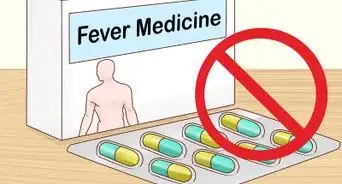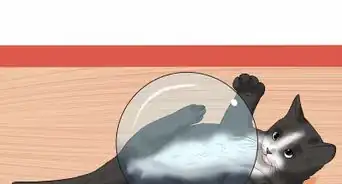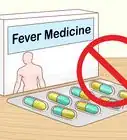This article was co-authored by Pippa Elliott, MRCVS and by wikiHow staff writer, Jessica Gibson. Dr. Elliott, BVMS, MRCVS is a veterinarian with over 30 years of experience in veterinary surgery and companion animal practice. She graduated from the University of Glasgow in 1987 with a degree in veterinary medicine and surgery. She has worked at the same animal clinic in her hometown for over 20 years.
There are 7 references cited in this article, which can be found at the bottom of the page.
This article has been viewed 14,499 times.
Cats are prone to a variety of diseases. One of the most infectious viral diseases is feline panleukopenia (which also goes by feline parvovirus, feline distemper, and feline infectious enteritis). This virus causes painful symptoms and has a high death rate, which is why cats are often vaccinated for it at an early age.[1] Take steps to protect your cat against this infectious disease, especially if you have kittens or several cats in your household.
Steps
Reducing Your Cat's Risk For Distemper
-
1Get your cat vaccinated. If you have a kitten, start the vaccination series between 6 and 9 weeks of age. Your kitten will need injections every 3 or 4 weeks until she's 16 weeks old. Your kitten will need a booster injection one year after the last kitten vaccine and then every 3 years thereafter. If you have an adult cat, she'll need just 2 initial injections (3 to 4 weeks apart), followed by a booster one year later and then a booster every three years.[2]
- Kittens need more early injections to prevent maternal antibodies from disabling the vaccine.
- This vaccine is considered to be a core or essential vaccine even for indoor cats. This is because the virus can be brought inside your home.[3]
-
2Deter animals from visiting your yard. Raccoons, foxes, and minks can carry the virus, so it's important to discourage them from spending time in your yard. Keep your yard fenced to prevent them from wandering in. You should also keep your garbage cans securely closed, put away any pet food that you keep outside, and consider sprinkling a repellent.[4]
- You should also try to keep feral or neighborhood cats out of your yard since there's no way of knowing if they carry the virus. Remove any food, cover sandboxes, and make your yard less appealing to other cats.[5]
Advertisement -
3Practice good hygiene. Since the virus can be easily brought into your house from outside, change your shoes, put on a new outfit, and wash your hands if you've been outside. This is mainly important if you'll be handling kittens that are nursing. You should always change into new shoes when coming inside if you have an inside cat that's not been vaccinated.
- Be especially cautious if you have a pregnant unvaccinated cat in your house. She can easily pass the virus on to the unborn kittens.[6]
-
4Keep your cat's food and water bowls clean. Wash your cat's food and water dishes every day using diluted bleach. If your cat is sick, you'll need to talk to the vet about using an effective disinfectant since the panleukopenia virus can survive many common household cleaners and steam cleaning. Your vet may recommend cleaning with a product that contains glutaraldehyde, formalin, or 1/32 solution of sodium hypochlorite (bleach).[7]
- Always use separate utensils for pets and for humans.
-
5Stop the virus from spreading. If one of your cats has the virus, prevent other cats in your house from getting the disease. Even once the cat has been treated for the virus, she'll continue to excrete the virus through her feces for up to 6 weeks. Vaccinate any other cats in your house and keep them away from the infected cat for at least a week after the final vaccine.[8]
- Cats can be infected indirectly (without having direct contact with a sick cat). For example, a cat might become infected by coming into contact with a contaminated water bowl.
Recognizing and Managing Feline Distemper
-
1Feel your cat for fever. If your cat gets the panleukopenia virus, it will incubate for 5 to 9 days before she starts showing symptoms. You might notice your cat develops a high fever.
- The fever may fluctuate and may be one of the earliest signs of the virus.[9]
-
2Pay attention to your cat's behavior. You may notice other signs that your cat has contracted the virus. Her appetite may drastically change and she may not want to eat. Your cat might seem tired, lethargic, and fatigued.[10] This is especially noticeable in kittens or if your cat is usually playful and energetic.
- Your cat's lack of appetite can also lead to dehydration.[11] Monitor how much water your cat drinks throughout the day.
-
3Watch for vomiting and diarrhea. Once the virus progresses (usually one or two days after the fever), your cat may suddenly develop bloody diarrhea and vomiting. If the virus has severely developed, your cat can hemorrhage. Some cats die quickly because their bodies can't keep up with the virus.[12] [13]
- The virus rapidly divides cells in your cat's gut and keeps white blood cells from fighting infection, causing these serious symptoms.[14]
-
4Get a medical diagnosis. The vet will take your cat's medical history, look for signs of the virus, and do a physical exam. Specifically, the vet will look for fever, dehydration, depression, thickened intestines, and enlarged lymph nodes in the abdomen. The vet will also order lab tests (like blood tests) in order to confirm a diagnosis.[15]
- If your cat has the virus, she'll have a low white blood count and possibly a low platelet count. A fecal or urine test is more expensive and takes more time, so the vet may only order these if trying to research whether or not your cat has the virus.
-
5Treat your cat. If you notice any signs of the panleukopenia virus, get your cat veterinary attention immediately. While mortality rates are high, your cat may recover with intensive nursing, intravenous fluids, drugs to relieve nausea, antibiotics for secondary infections, and in some cases a blood transfusion.[16]
- Unfortunately, there's no cure for the virus and the majority of infected cats die, with some passing away before the gastrointestinal (vomiting and diarrhea) signs start.
Expert Q&A
-
QuestionCan panleukopenia be cured?
 Pippa Elliott, MRCVSDr. Elliott, BVMS, MRCVS is a veterinarian with over 30 years of experience in veterinary surgery and companion animal practice. She graduated from the University of Glasgow in 1987 with a degree in veterinary medicine and surgery. She has worked at the same animal clinic in her hometown for over 20 years.
Pippa Elliott, MRCVSDr. Elliott, BVMS, MRCVS is a veterinarian with over 30 years of experience in veterinary surgery and companion animal practice. She graduated from the University of Glasgow in 1987 with a degree in veterinary medicine and surgery. She has worked at the same animal clinic in her hometown for over 20 years.
Veterinarian There is no cure for this viral disease. However, aggressive supportive care with intravenous fluids helps prevent complications such as dehydration and gives the cat's immune system a chance to mount a defense.
There is no cure for this viral disease. However, aggressive supportive care with intravenous fluids helps prevent complications such as dehydration and gives the cat's immune system a chance to mount a defense. -
QuestionCan a cat recover from distemper?
 Pippa Elliott, MRCVSDr. Elliott, BVMS, MRCVS is a veterinarian with over 30 years of experience in veterinary surgery and companion animal practice. She graduated from the University of Glasgow in 1987 with a degree in veterinary medicine and surgery. She has worked at the same animal clinic in her hometown for over 20 years.
Pippa Elliott, MRCVSDr. Elliott, BVMS, MRCVS is a veterinarian with over 30 years of experience in veterinary surgery and companion animal practice. She graduated from the University of Glasgow in 1987 with a degree in veterinary medicine and surgery. She has worked at the same animal clinic in her hometown for over 20 years.
Veterinarian If the condition is caught early and the cat receives aggressive supportive care, there is a chance of recovery. Whilst no drugs 'cure' feline distemper, it is thought that medications such as interferon can help the immune system overcome the virus in some cases.
If the condition is caught early and the cat receives aggressive supportive care, there is a chance of recovery. Whilst no drugs 'cure' feline distemper, it is thought that medications such as interferon can help the immune system overcome the virus in some cases. -
QuestionCan feline distemper be cured?
 Pippa Elliott, MRCVSDr. Elliott, BVMS, MRCVS is a veterinarian with over 30 years of experience in veterinary surgery and companion animal practice. She graduated from the University of Glasgow in 1987 with a degree in veterinary medicine and surgery. She has worked at the same animal clinic in her hometown for over 20 years.
Pippa Elliott, MRCVSDr. Elliott, BVMS, MRCVS is a veterinarian with over 30 years of experience in veterinary surgery and companion animal practice. She graduated from the University of Glasgow in 1987 with a degree in veterinary medicine and surgery. She has worked at the same animal clinic in her hometown for over 20 years.
Veterinarian There is no cure for feline distemper, but some cats do pull through when given supportive care. Feline distemper is a viral disease and antibiotics are only effective against bacteria. However, there is hope that therapy with feline interferon may strength the cat's immune system and help them to fight off infection.
There is no cure for feline distemper, but some cats do pull through when given supportive care. Feline distemper is a viral disease and antibiotics are only effective against bacteria. However, there is hope that therapy with feline interferon may strength the cat's immune system and help them to fight off infection.
References
- ↑ http://www.merckvetmanual.com/mvm/generalized_conditions/feline_panleukopenia/overview_of_feline_panleukopenia.html
- ↑ http://icatcare.org/advice/cat-health/feline-infectious-enteritis-parvovirus-panleukopenia-virus
- ↑ https://www.researchgate.net/publication/26251979_Feline_Panleukopenia_ABCD_guidelines_on_prevention_and_management
- ↑ http://www.urbanwildliferescue.org/humane/raccoons.htm
- ↑ http://www.catbehaviorassociates.com/how-to-keep-cats-out-of-your-yard/
- ↑ http://icatcare.org/advice/cat-health/feline-infectious-enteritis-parvovirus-panleukopenia-virus
- ↑ https://www.researchgate.net/publication/26251979_Feline_Panleukopenia_ABCD_guidelines_on_prevention_and_management
- ↑ http://www.merckvetmanual.com/mvm/generalized_conditions/feline_panleukopenia/overview_of_feline_panleukopenia.html
- ↑ http://icatcare.org/advice/cat-health/feline-infectious-peritonitis-fip
- ↑ http://icatcare.org/advice/cat-health/feline-infectious-peritonitis-fip
- ↑ http://www.merckvetmanual.com/mvm/generalized_conditions/feline_panleukopenia/overview_of_feline_panleukopenia.html
- ↑ http://icatcare.org/advice/cat-health/feline-infectious-enteritis-parvovirus-panleukopenia-virus
- ↑ http://www.merckvetmanual.com/mvm/generalized_conditions/feline_panleukopenia/overview_of_feline_panleukopenia.html
- ↑ http://icatcare.org/advice/cat-health/feline-infectious-enteritis-parvovirus-panleukopenia-virus
- ↑ http://www.peteducation.com/article.cfm?c=1+2139&aid=222
- ↑ http://www.merckvetmanual.com/mvm/generalized_conditions/feline_panleukopenia/overview_of_feline_panleukopenia.html
- ↑ https://www.researchgate.net/publication/26251979_Feline_Panleukopenia_ABCD_guidelines_on_prevention_and_management
About This Article
The best way to prevent feline panleukopenia, also known as distemper, is to get your cat vaccinated immediately. After that, you can reduce your cat's risk further by fencing in your yard, which will deter close visits from animals that can carry the virus, such as raccoons, foxes, minks, and feral cats. However, because distemper can travel inside very easily, you should still check your cat for symptoms like high fever, fatigue, decreased appetite, vomiting, and diarrhea. Since distemper has such a high mortality rate, contact your veterinarian immediately if your cat starts showing symptoms. For more advice from our Veterinary co-author, including how to treat feline panleukopenia, read on.
-Step-1.webp)
-Step-2.webp)
-Step-3.webp)
-Step-4.webp)
-Step-5.webp)
-Step-6.webp)
-Step-7.webp)
-Step-8.webp)
-Step-9.webp)
-Step-10.webp)







-Step-18.webp)
-Step-12.webp)
















































